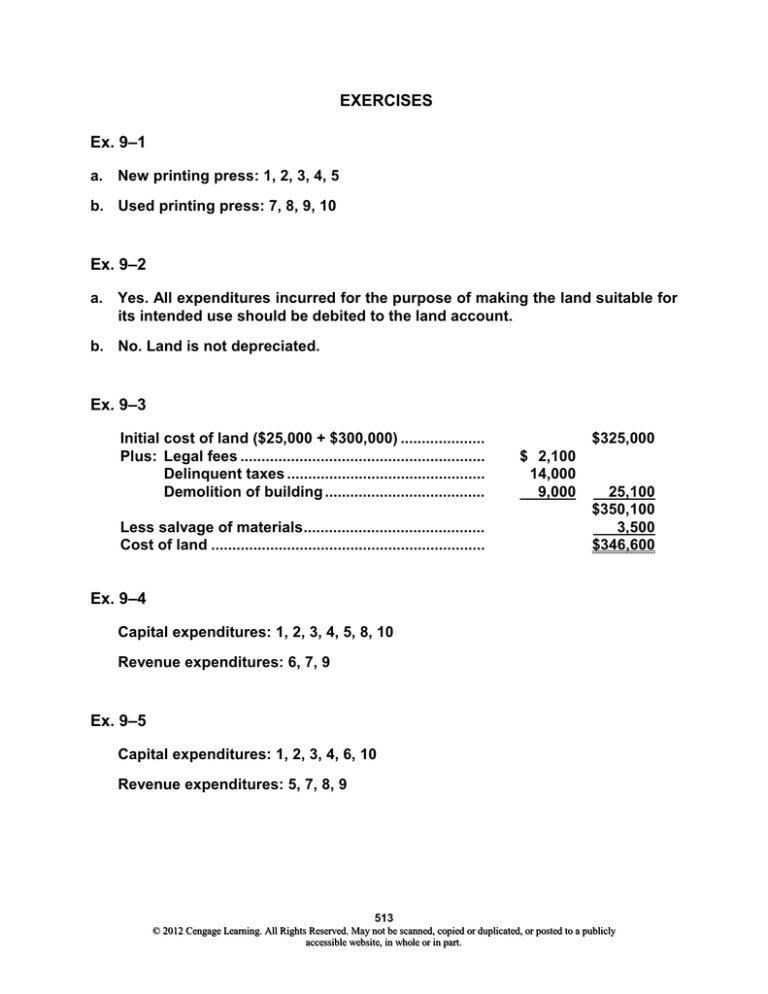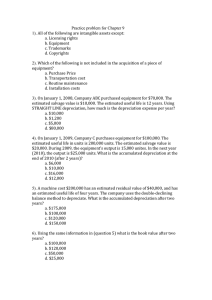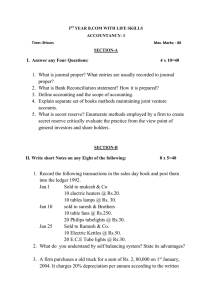
EXERCISES
Ex. 9–1
a. New printing press: 1, 2, 3, 4, 5
b. Used printing press: 7, 8, 9, 10
Ex. 9–2
a. Yes. All expenditures incurred for the purpose of making the land suitable for
its intended use should be debited to the land account.
b. No. Land is not depreciated.
Ex. 9–3
Initial cost of land ($25,000 + $300,000) ....................
Plus: Legal fees ..........................................................
Delinquent taxes ...............................................
Demolition of building ......................................
Less salvage of materials ...........................................
Cost of land .................................................................
$325,000
$ 2,100
14,000
9,000
25,100
$350,100
3,500
$346,600
Ex. 9–4
Capital expenditures: 1, 2, 3, 4, 5, 8, 10
Revenue expenditures: 6, 7, 9
Ex. 9–5
Capital expenditures: 1, 2, 3, 4, 6, 10
Revenue expenditures: 5, 7, 8, 9
513
© 2012 Cengage Learning. All Rights Reserved. May not be scanned, copied or duplicated, or posted to a publicly
accessible website, in whole or in part.
Ex. 9–6
Feb.
4 Accumulated Depreciation—Delivery Truck.....
Cash................................................................
4,300
6 Delivery Truck .....................................................
Cash................................................................
1,900
Sept. 10 Repairs and Maintenance Expense ...................
Cash................................................................
60
May
4,300
1,900
60
Ex. 9–7
a. No. The $7,500,000 represents the original cost of the equipment. Its replacement cost, which may be more or less than $7,500,000, is not reported in
the financial statements.
b. No. The $6,175,000 is the accumulation of the past depreciation charges on
the equipment. The recognition of depreciation expense has no relationship
to the cash account or accumulation of cash funds.
Ex. 9–8
(a) 25% (1/4), (b) 12.5% (1/8), (c) 10% (1/10), (d) 6.25% (1/16), (e) 4% (1/25), (f) 2.5%
(1/40), (g) 2% (1/50)
Ex. 9–9
$6,625 [($120,000 – $14,000)/16]
Ex. 9–10
$185,000 $37,000
= $3.70 depreciation per hour
40,000 hours
140 hours at $3.70 = $518 depreciation for February
514
© 2012 Cengage Learning. All Rights Reserved. May not be scanned, copied or duplicated, or posted to a publicly
accessible website, in whole or in part.
Ex. 9–11
a. Depreciation per Rate per Mile:
Truck #1
($75,000 – $15,000)/200,000 = $0.30
Truck #2
($38,000 – $3,000)/200,000 = $0.175
Truck #3
($72,900 – $9,900)/300,000 = $0.21
Truck #4
($90,000 – $20,000)/250,000 = $0.28
Truck No.
Rate per Mile
Credit to
Accumulated
Depreciation
Miles Operated
1
30.0 cents
19,500
2
17.5
36,000
3
21.0
25,000
4
28.0
26,000
Total .............................................................................................
$ 5,850
6,300
2,100*
7,280
$21,530
*Mileage depreciation of $5,250 (21 cents × 25,000) is limited to $2,100, which
reduces the book value of the truck to $9,900, its residual value.
b. Depreciation Expense—Trucks ....................................
Accumulated Depreciation—Trucks .......................
Truck depreciation.
21,530
Ex. 9–12
First Year
a.
4% of $80,000 = $3,200
Second Year
4% of $80,000 = $3,200
or
b.
or
($80,000/25) = $3,200
($80,000/25) = $3,200
8% of $80,000 = $6,400
8% of ($80,000 – $6,400) = $5,888
Ex. 9–13
a. 6 1/4% of ($344,000 – $50,000) = $18,375 or [($344,000 – $50,000)/16]
b. Year 1: 12.5% of $344,000 = $43,000
Year 2: 12.5% of ($344,000 – $43,000) = $37,625
515
© 2012 Cengage Learning. All Rights Reserved. May not be scanned, copied or duplicated, or posted to a publicly
accessible website, in whole or in part.
21,530
Ex. 9–14
a. Year 1: 9/12 × [($64,000 – $4,000)/8] = $5,625
Year 2: ($64,000 – $4,000)/8 = $7,500
b. Year 1: 9/12 × 25% of $64,000 = $12,000
Year 2: 25% of ($64,000 – $12,000) = $13,000
Ex. 9–15
a. $16,250 [($900,000 – $250,000)/40]
b. $510,000 [$900,000 – ($16,250 × 24 yrs.)]
c. $30,000 [($510,000 – $240,000)/9 yrs.]
Ex. 9–16
a.
June 30 Carpet ............................................................
Cash .........................................................
15,000
b. Dec. 31 Depreciation Expense..................................
Accumulated Depreciation.....................
Carpet depreciation
[($15,000/12 years) × 1/2].
625
15,000
625
Ex. 9–17
a.
Cost of equipment ....................................................................
Accumulated depreciation at December 31, 2012
(4 years at $21,250* per year) .............................................
Book value at December 31, 2010 ...........................................
*($380,000 – $40,000)/16 = $21,250
$380,000
85,000
$295,000
b. (1) Depreciation Expense—Equipment ......................
Accumulated Depreciation—Equipment .........
Truck depreciation ($21,250 × 6/12 = $10,625).
10,625
(2) Cash .........................................................................
Accumulated Depreciation—Equipment...............
Loss on Sale of Equipment ....................................
Equipment ..........................................................
*($85,000 + $10,625 = $95,625)
270,000
95,625*
14,375
10,625
516
© 2012 Cengage Learning. All Rights Reserved. May not be scanned, copied or duplicated, or posted to a publicly
accessible website, in whole or in part.
380,000
Ex. 9–18
a.
2009 depreciation expense: $40,000 [($425,000 – $65,000)/9]
2010 depreciation expense: $40,000
2011 depreciation expense: $40,000
b. $305,000 [$425,000 – ($40,000 × 3)]
c.
Cash ................................................................................
Accumulated Depreciation—Equipment .....................
Loss on Disposal of Fixed Assets ...............................
Equipment.................................................................
290,000
120,000
15,000
d. Cash ................................................................................
Accumulated Depreciation—Equipment .....................
Equipment.................................................................
Gain on Sale of Equipment .....................................
310,000
120,000
425,000
425,000
5,000
Ex. 9–19
a. $15,000,000/120,000,000 tons = $0.125 depletion per ton
24,000,000 × $0.125 = $3,000,000 depletion expense
b. Depletion Expense ........................................................
Accumulated Depletion ...........................................
Depletion of mineral deposit.
3,000,000
3,000,000
Ex. 9–20
a. ($300,000/12) + ($72,000/9) = $33,000 total patent expense
b. Amortization Expense—Patents ..................................
Patents ......................................................................
Amortized patent rights ($25,000 + $8,000).
33,000
517
© 2012 Cengage Learning. All Rights Reserved. May not be scanned, copied or duplicated, or posted to a publicly
accessible website, in whole or in part.
33,000
Ex. 9–21
a. Property, Plant, and Equipment (in millions):
Land and buildings....................................................
Machinery, equipment, and internal-use software .
Office furniture and equipment ................................
Other fixed assets related to leases ........................
Less accumulated depreciation ...............................
Book value .................................................................
Current
Year
Preceding
Year
$ 955
1,932
115
1,665
$4,667
1,713
$2,954
$ 810
1,491
122
1,324
$3,747
1,292
$2,455
A comparison of the book values of the current and preceding years indicates
that they increased. A comparison of the total cost and accumulated depreciation reveals that Apple purchased $920 million ($4,667 – $3,747) of additional
fixed assets, which was offset by the additional depreciation expense of $421
million ($1,713 – $1,292) taken during the current year.
b. The book value of fixed assets should normally increase during the year. Although additional depreciation expense will reduce the book value, most
companies invest in new assets in an amount that is at least equal to the
depreciation expense. However, during periods of economic downturn, companies purchase fewer fixed assets, and the book value of their fixed assets
may decline.
Ex. 9–22
1.
Fixed assets should be reported at cost and not replacement cost.
2.
Land does not depreciate.
3.
Patents and goodwill are intangible assets that should be listed in a separate
section following the Fixed Assets section. Patents should be reported at
their net book values (cost less amortization to date). Goodwill should not be
amortized, but should be only written down upon impairment.
518
© 2012 Cengage Learning. All Rights Reserved. May not be scanned, copied or duplicated, or posted to a publicly
accessible website, in whole or in part.
Ex. 9–23
a. Fixed Asset Turnover Ratio =
Fixed Asset Turnover Ratio =
Revenue
Average Book Value of Fixed Assets
$107,808
($91,466 + $86,546)/2
Fixed Asset Turnover Ratio = 1.21
b. Verizon earns $1.21 revenue for every dollar of fixed assets. This is a low
fixed asset turnover ratio, reflecting the high fixed asset intensity in a telecommunications company. The industry average fixed asset turnover ratio is
slightly lower at 1.10. Thus, Verizon is using its fixed assets slightly more
efficiently than the industry as a whole.
Ex. 9–24
a. Best Buy: 12.04 ($45,015/$3,740)
RadioShack: 13.54 ($4,225/$312)
b. RadioShack’s fixed asset turnover ratio of 13.54 is higher than Best Buy’s
fixed asset turnover ratio of 12.04. Thus, RadioShack is generating $1.50
($13.54 – $12.04) more revenue for each dollar of fixed assets than is Best
Buy. On this basis, RadioShack is managing its fixed assets slightly more
efficiently than is Best Buy.
Appendix Ex. 9–25
a.
Price (fair market value) of new equipment ...............................
Trade-in allowance of old equipment .........................................
Cash paid on the date of exchange ............................................
$400,000
175,000
$225,000
b.
Price (fair market value) of new equipment ..............
Less assets given up in exchange:
Book value of old equipment..............................
Cash paid on the exchange ................................
Gain on exchange of equipment ................................
$400,000
$160,000
225,000
385,000
$ 15,000
519
© 2012 Cengage Learning. All Rights Reserved. May not be scanned, copied or duplicated, or posted to a publicly
accessible website, in whole or in part.







